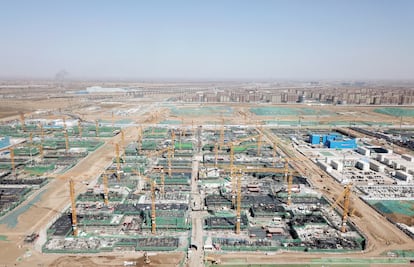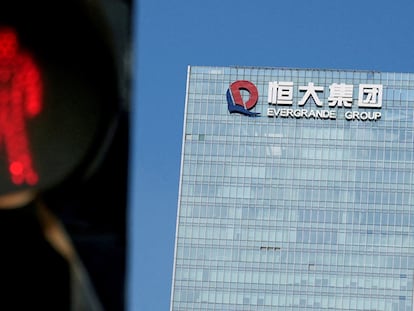Xiongan, the new ‘socialist’ city dreamed up by Chinese President Xi Jinping
China is building a city about 60 miles from Beijing to relieve congestion in the capital. The president affirms that it’s a project of ‘millennial significance’ that shall withstand the ‘test of history’


Five retired farmers are sitting on the bus. They have the tanned faces of those who have worked the land. They know the area well. They’ve lived their entire lives in this corner of China, far from the maddening crowdedness of modernity.
They point to the right, where tractors operate among mountains of rubble: there, the demolition of an old village has begun; To the left, there’s a barren esplanade: this is going to be another Peking University campus. Further ahead, there’s a white construction project underway, with a futuristic air: it’s going to be a new sports stadium. And that road over there, they point, is the highway that takes you to Beijing.
These residents usually spend their time on the bus looking at the landscape. They go from their houses — given to them by the government, in exchange for their old, expropriated homes to the new high-speed train station, and then back. Mr. Li — who is in his 70s — says they’re now living “the good days.”
As time passes, the retirees see Xiongan grow around them — a city created from nothing, on the same land where they used to work. It aspires to be a prototype of a “modern socialist” city, one of the most ambitious projects proposed by Chinese President Xi Jinping.
Conceived as a satellite city of Beijing, there are construction grids, cranes and cement trucks everywhere. The chosen site is a plain crossed by rivers and wetlands, about 60 miles south of the Chinese capital, in the province of Hebei. Its development was announced in 2017, as an escape valve from the congested capital of the Asian giant, where almost 22 million people live. The intention is to encourage the transfer of companies and institutions, thus freeing Beijing of functions that aren’t essential for the operation of the national government.
Xiongan bears President Xi’s personal seal. The general secretary of the Chinese Communist Party has called it a “national project of millennial significance,” which must be able to “withstand the test of history.” Its planning — as he has reiterated — aims to combine cutting-edge technology and respect for the environment. “This is also the legacy that our generation of Chinese communists will bequeath to future generations,” Xi said. Xiongan — an acronym for two counties in the area — is also a newly-coined word made up of two characters: 雄 (Xiong: hero, masculine, strength) and 安 (An: peace, calm, stability). It will be a legacy with which to evaluate the era of Xi, who, last year, achieved an unprecedented third presidential term among his immediate predecessors.

The government has compared its implementation with two milestones: Shenzhen — the country’s first special economic zone, created in 1980 in a fishing village that has today been
transformed into a technology megalopolis — and Pudong, Shanghai’s financial district with futuristic skyscrapers. Both projects were promoted in the 1980s by Chairman Deng Xiaoping, architect of the period of opening and reform that triggered Chinese development.
Beijing has put the machinery into operation. In almost seven years, more than 4,000 buildings have begun to rise on the former barren lands and ruined towns. The area has received investments of more than 657 billion yuan (more than $90 billion) and Chinese state companies have already established more than 200 subsidiaries and branches in the area, according to figures released by state media. Among the projects under construction is a supercomputing center (the “brain of the city”) that will help power some of Xiongan’s digital systems, including platforms for managing traffic and autonomous vehicles. Since 2021, the city is also a testing ground for the digital yuan, backed by the Chinese Central Bank. The urban planning requires that basic services be within a 15-minute walking distance from every resident, while requiring that energy come primarily from clean sources. 70% of the city is reserved for green areas.
Andrew Stokols — a doctoral candidate in urban planning and policy at MIT — considers Xiongan to be a “techno-naturalist utopia,” as he wrote last year in The China Project. The city, he added, has acquired “ideological importance” as a “national template of high-quality development,” one of Beijing’s mantras in recent years. “Xiong’an has become a physical embodiment of Xi’s party-state capitalism: re-centering the Chinese Communist Party in urban life, promoting high-tech and green innovation through investment in universities, state research institutes and SOEs (state-owned enterprises).”
Stokols acknowledges that many utopian cities have failed in the past. But he believes Xi’s “commitment” to Xiongan as a “legacy” could ensure that the city continues to receive support from the central government. And, over time, he adds, it could prove “attractive” as a center for research, innovation and a decent quality of life, especially for young university graduates from secondary towns or cities in China.
For now, it still seems to be quite empty. On a Wednesday, the high-speed train — which takes less than an hour from Beijing and costs $8 a trip — arrives with few passengers: the majority get off at Daxing airport, to the south of the capital, from where it takes about 20 minutes to reach Xiongan. The city station — inaugurated in 2020 — is gigantic, with white, sinuous lines, with the roofs covered by solar panels. Inside, you can barely see a soul — its hallways are deserted. The waiting rooms are without people. But its dimensions and its multiple platforms allow us to sense the imagined scale.
At the exit, there are advertisements for luxury homes: “Work in Xiongan, live in a palace,” one reads. In the surroundings, you can see wastelands and skeletons of buildings. From there, one can take the aforementioned bus with the retirees. For the rest of the journey — which lasts about an hour — no one else boards. “Maybe it’s too early to write [about Xiongan], the change hasn’t been noticed yet,” one of the elders reflects.
The bus leaves next to an avenue that is dotted with red posters hanging from streetlights: “national project” and “millennium plan” are common messages from Xi. The China State Construction Engineering Corporation — one of the largest in the world in its sector — now has its headquarters in this area. Several restaurants have opened on the next block. At the door of one of them, chef Guan Wei, 43, says that he moved here in 2022 with his family from Dongbei, in northwest China. “There are many state-owned enterprises in Xiongan,” Guan says. He calls the city “Little Beijing.” In his opinion, “it has very good prospects for the restaurant business in the future.” At their location, there’s a lunch atmosphere on a weekday. Three employees of an engineering company in Tianjin — a coastal city, located about 60 miles away — are eating. Their city is part of the Beijing-Hebei-Tianjin economic development triangle, in which the new city is framed.
Nearby is the Rongdong district, where identical housing blocks multiply. There are also international hotels, futuristic office buildings and an affluent shopping center, with a food court, cinemas and shops selling luxury brands. This area — located next to a large park — is expected to articulate residential life, although many of the spaces are still under construction… or empty. It’s worth wondering if the economic slowdown in China will also be felt here.
At the moment, a good part of the inhabitants are relocated residents, construction workers, or people like Hu Yan, 36, who works at an interior design company in charge of several projects. He lives in one of the recently-finished housing blocks during the week, while he returns to his family in the capital every weekend. He believes that, in the future, Xiongan “will be like Beijing.”
“It’s going to be a lot better in a couple of years. There will be schools, universities will come,” says Qiu Ping, 45, a primary school teacher at a local school. She meets her young son and her mother at the Xiongan Museum. They usually come after school: her little one likes to play with an interactive real estate development game that’s located in one of the exhibits. In front of a model of the new city, Qiu says: “This, until three years ago, was agricultural land.” The family — born here — has rural roots. “Now, we’re urban residents,” she emphasizes. The government also expropriated her property and gave her a new home in exchange. She uses the same expression as the retirees: “the good days” have arrived.
In the museum — with a profusion of screens and lighting effects — at one point, you cross a corridor in which a number shines: 2035. By then, according to Beijing’s plan, Xiongan “will have basically become a modern, green city… intelligent and habitable.” By 2050, the authorities expect it to be placed on the map of large world-class cities as a prototype of a “modern socialist city.”
“Each era has its models and symbols,” concludes another panel at the museum, highlighting how Xiongan — “under the personal [planning and approval] of General Secretary Xi Jinping” — will be “an important witness and participant in China’s great rejuvenation.” With this expression, Beijing usually refers to the recovery of its status, which was lost globally after the so-called “century of humiliation” that followed its defeat by the colonial powers. “The drums are sounding,” the panel concludes.
Sign up for our weekly newsletter to get more English-language news coverage from EL PAÍS USA Edition
Tu suscripción se está usando en otro dispositivo
¿Quieres añadir otro usuario a tu suscripción?
Si continúas leyendo en este dispositivo, no se podrá leer en el otro.
FlechaTu suscripción se está usando en otro dispositivo y solo puedes acceder a EL PAÍS desde un dispositivo a la vez.
Si quieres compartir tu cuenta, cambia tu suscripción a la modalidad Premium, así podrás añadir otro usuario. Cada uno accederá con su propia cuenta de email, lo que os permitirá personalizar vuestra experiencia en EL PAÍS.
¿Tienes una suscripción de empresa? Accede aquí para contratar más cuentas.
En el caso de no saber quién está usando tu cuenta, te recomendamos cambiar tu contraseña aquí.
Si decides continuar compartiendo tu cuenta, este mensaje se mostrará en tu dispositivo y en el de la otra persona que está usando tu cuenta de forma indefinida, afectando a tu experiencia de lectura. Puedes consultar aquí los términos y condiciones de la suscripción digital.
More information
Archived In
Últimas noticias
There is as much life left to discover on planet Earth as that which is already known
Dozens presumed dead, around 100 injured in fire at Swiss Alps bar during New Year’s celebration
Is porn for women different from conventional porn? We spoke to those who make it
Cartagena de Indias is sinking: What can the city do to mitigate it?
Most viewed
- Sinaloa Cartel war is taking its toll on Los Chapitos
- Reinhard Genzel, Nobel laureate in physics: ‘One-minute videos will never give you the truth’
- Oona Chaplin: ‘I told James Cameron that I was living in a treehouse and starting a permaculture project with a friend’
- David King, chemist: ‘There are scientists studying how to cool the planet; nobody should stop these experiments from happening’
- Why the price of coffee has skyrocketed: from Brazilian plantations to specialty coffee houses









































